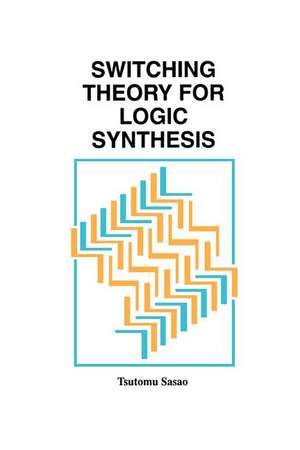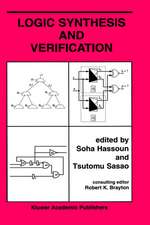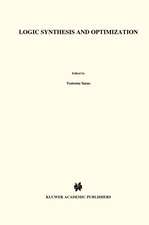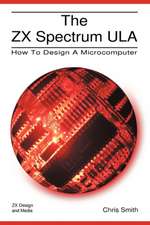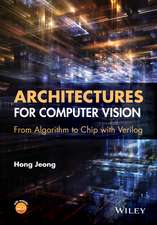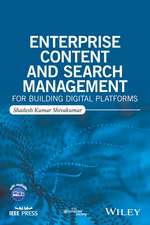Switching Theory for Logic Synthesis
Autor Tsutomu Sasaoen Limba Engleză Paperback – 4 oct 2012
An appendix providing a history of switching theory is included. The reference list consists of over four hundred entries.
Switching Theory for Logic Synthesis is based on the author's lectures at Kyushu Institute of Technology as well as seminars for CAD engineers from various Japanese technology companies.
Switching Theory for Logic Synthesis will be of interest to CAD professionals and students at the advanced level. It is also useful as a textbook, as each chapter contains examples, illustrations, and exercises.
| Toate formatele și edițiile | Preț | Express |
|---|---|---|
| Paperback (1) | 991.27 lei 6-8 săpt. | |
| Springer Us – 4 oct 2012 | 991.27 lei 6-8 săpt. | |
| Hardback (1) | 997.56 lei 6-8 săpt. | |
| Springer Us – 28 feb 1999 | 997.56 lei 6-8 săpt. |
Preț: 991.27 lei
Preț vechi: 1239.09 lei
-20% Nou
Puncte Express: 1487
Preț estimativ în valută:
189.68€ • 195.69$ • 158.29£
189.68€ • 195.69$ • 158.29£
Carte tipărită la comandă
Livrare economică 26 martie-09 aprilie
Preluare comenzi: 021 569.72.76
Specificații
ISBN-13: 9781461373391
ISBN-10: 1461373395
Pagini: 380
Ilustrații: XI, 362 p.
Dimensiuni: 155 x 235 x 20 mm
Greutate: 0.54 kg
Ediția:Softcover reprint of the original 1st ed. 1999
Editura: Springer Us
Colecția Springer
Locul publicării:New York, NY, United States
ISBN-10: 1461373395
Pagini: 380
Ilustrații: XI, 362 p.
Dimensiuni: 155 x 235 x 20 mm
Greutate: 0.54 kg
Ediția:Softcover reprint of the original 1st ed. 1999
Editura: Springer Us
Colecția Springer
Locul publicării:New York, NY, United States
Public țintă
ResearchCuprins
1 Mathematical Foundation.- 1.1 Set.- 1.2 Relation.- 1.3 Equivalence Class.- 1.4 Function.- 1.5 Ordered Set.- 2 Lattice and Boolean Algebra.- 2.1 Algebra.- 2.2 Lattice.- 2.3 Distributive Lattice and Complemented Lattice.- 2.4 Boolean Algebra.- 2.5 Logic Function.- 2.6 Group, Ring, and Field.- 3 Logic Functions and Their Representations.- 3.1 Logic Elements and Logic Networks.- 3.2 Logic Functions and Combinational Networks.- 3.3 SOP and POS.- 3.4 Shannon Expansion.- 3.5 Reed-Muller Expression.- 3.6 Logical Expressions and Multi-Level Logic Networks.- 3.7 Binary Decision Diagram.- 3.8 Comparison of Representation Methods.- 3.9 Logical Equations and Propositional Calculus.- 4 Optimization of and-or Two-Level Logic Networks.- 4.1 SOPs and Two-Level Logic Networks.- 4.2 n-Dimensional Cube.- 4.3 Karnaugh Map.- 4.4 Prime Implicant.- 4.5 Minimum SOP.- 4.6 Simplification of SOPs with Karnaugh Map.- 4.7 Quine-McCluskey Method.- 4.8 MSOPs and their Applications.- 4.9 Simplification of Multi-Output Networks.- 5 Logic Functions with Various Properties.- 5.1 Self-Dual Function.- 5.2 Monotone Function and Unate function.- 5.3 Linear Function.- 5.4 Symmetric Function.- 5.5 Threshold Function.- 5.6 Universal Set of Logic Functions.- 5.7 Equivalence Classes of Logic Functions.- 6 Sequential Networks.- 6.1 Introduction to Sequential Networks.- 6.2 Flip-Flops.- 6.3 Representation of Sequential Networks.- 6.4 State Assignment and State Table.- 6.5 Realization of Sequential Networks.- 7 Optimization of Sequential Networks.- 7.1 Optimization of Completely Specified Sequential Machines.- 7.2 Optimization of Incompletely Specified Sequential Machines.- 7.3 State Assignment.- 8 Delay and Asynchronous Behavior.- 8.1 Transient Response of Combinational Networks.- 8.2 Asynchronous Sequential Networks.- 8.3 Malfunctions of Asynchronous Sequential Networks.- 9 Multi-Valued Input Two-Valued Output Function.- 9.1 Multi-Valued Input Two-Valued Output Function.- 9.2 Bit Representation.- 9.3 Restriction.- 9.4 Tautology.- 9.5 Inclusion Relation.- 9.6 Equivalence.- 9.7 Divide and Conquer Method.- 9.8 Complementation of SOPs.- 9.9 Tautology Decision.- 9.10 Generation of Prime Implicants.- 9.11 Sharp Operation.- 10 Heuristic Optimization of Two-Level Networks.- 10.1 Simplification of SOPs with Many Inputs.- 10.2 Merge, Expansion, and Delete.- 10.3 Reduce and Reshape.- 10.4 Detection of Essential Prime Implicants.- 10.5 Multi-Output Function.- 10.6 PRESTO.- 10.7 MINI and ESPRESSO.- 10.8 Encoding Method for Combinational Networks.- 10.9 State Assignment for Sequential Networks.- 11 Multi-Level Logic Synthesis.- 11.1 Logic Synthesis System.- 11.2 Factoring using Product Terms.- 11.3 Two-Variable Function Generator.- 11.4 Algebraic Division of Logical Expressions.- 11.5 Functional Decomposition.- 11.6 Transformation of Networks.- 11.7 Simplification using Don’t Care.- 11.8 Boolean Relation.- 11.9 Timing Optimization.- 12 Logic Design Using Modules.- 12.1 Logic Design using PLAs.- 12.2 Design using Multiplexers.- 12.3 Logic Design using ROMs.- 13 Logic Design Using Exors.- 13.1 Classification of AND-EXOR Expressions.- 13.2 Simplification of ESOPs.- 13.3 Fault Detection and Boolean Difference.- 14 Complexity of Logic Networks.- 14.1 Complexity of Two-Level Logic Networks.- 14.2 Complexity of Multi-Level Logic Networks.- A History of Switching Theory.- References.
